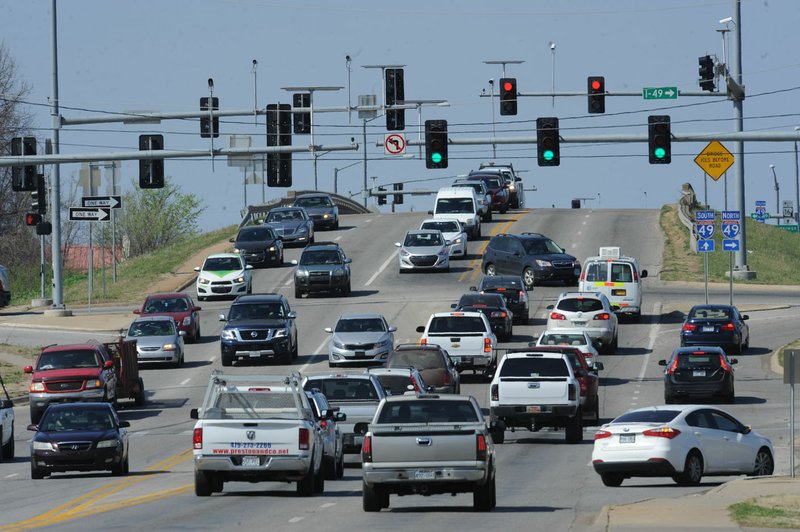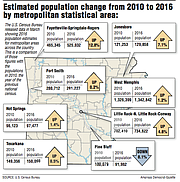Northwest Arkansas was the 22nd fastest-growing metropolitan area in the country last year, according to population estimates released today by the U.S. Census Bureau.
The estimated population of the Fayetteville-Springdale-Rogers metropolitan statistical area increased 11,583 -- or 2.3 percent -- from 513,449 to 525,032 between 2015 and 2016, according to the Census Bureau. The metro area's population grew 12.8 percent since 2010.
The Northwest Arkansas metropolitan area includes Benton, Madison and Washington counties in Arkansas and McDonald County in Missouri.
The rankings are based on percentage growth. Northwest Arkansas ranked No. 25 the previous year.
Most of the growth from 2015 to 2016 came from the 6,564 residents who moved to Northwest Arkansas from other states or other parts of Arkansas, according to the new census estimates.
"The majority of our growth comes from people moving in, indicative of the economic opportunities available here," said Mervin Jebaraj, assistant director for the Center for Business and Economic Research at the University of Arkansas. "The major employers recruit strongly from different regions all over the country."
Jebaraj is in line to become the research center's interim director next month. The center frequently reports on economic conditions for the region and state.
The vendors for major employers, especially Wal-Mart, bring in residents, Jebaraj said.
Northwest Arkansas' unemployment rate dropped to 2.8 percent in January, the U.S. Bureau of Labor Statistics reported this month. Jebaraj said one way to fill jobs is to bring people in from other areas.
Mike Harvey, interim CEO for the Northwest Arkansas Council, said the region lost jobs in 2008 and 2009, but had an average annual job growth of 9,600 to 11,500 for 2014, 2015 and 2016.
Job growth dropped off in the fall, leading Harvey to worry low unemployment was stifling the region's ability to grow.
The slowdown likely was a pause, he said.
Civic and business leaders across the region are intent on continuing the growth, Harvey said.
"It always seems like they're looking at what's next," he said. "There's a real concerted effort to raise the standard of living here. The people are a byproduct."
In the coming months, the Census Bureau will release 2016 population estimates for cities and towns, as well as national, state and county population estimates by age, sex, race and Hispanic origin, according to a news release.
Fastest growing areas
The three fastest-growing metropolitan areas in the country were The Villages, Fla., with a 4.3 percent increase; Myrtle Beach-Conway-North Myrtle Beach, S.C.-N.C., with a 3.9 percent increase; and Bend-Redmond, Ore., with a 3.6 percent increase.
The Villages is a retirement community west of Orlando whose metropolitan area includes all of Sumter County, Fla. This was the fourth year in a row The Villages ranked No. 1 in percentage population growth. Its 2016 population was estimated at 123,996.
Two metropolitan areas in Texas -- Dallas and Houston -- had the largest numerical increases in population, according to the Census Bureau. Each grew by more than 100,000 between 2015 and 2016.
Four metro areas were among both the 25 fastest growing and the 25 largest numeric gaining between 2015 and 2016: Austin, Texas; Raleigh, N.C.; Orlando, Fla.; and Las Vegas. For all four areas, net domestic migration was a larger component of change than either net international migration or natural increase, according to a news release from the Census Bureau.
Among the nation's 10 largest metro areas, Chicago was the only one that didn't grow in population between 2015 and 2016. The Chicago metro area -- America's third largest -- had a decrease of 19,570, or 0.2 percent, for 9,512,999.
Arkansas metro areas
Seven of Arkansas' eight metropolitan areas grew in population from 2015 to 2016, but not as much as Northwest Arkansas.
The Jonesboro metro area was second in Arkansas -- and 105th nationwide -- with an increase of 1.1 percent from 128,390 to 129,858. Since 2010, Jonesboro has seen a 7.1 percent increase in population. The Jonesboro metro area includes Craighead and Poinsett counties.
"In the past five to eight years, we've put a plan in place -- a structure that focused on safety, jobs, highways and quality of life," said Jonesboro Mayor Harold Perrin. "One of the biggest factors in our growth is the medical community. We are currently experiencing more than $1 billion in medical expansion, and we are one year into the medical school program at Arkansas State University."
The Little Rock-North Little Rock-Conway metro area was third in Arkansas -- and 213th nationwide -- with an increase of 0.4 percent from 731,542 to 734,622. Since 2010, the Little Rock metro area has had an increase in population of 4.6 percent. The Little Rock metro area includes Faulkner, Grant, Lonoke, Perry, Pulaski and Saline counties.
The Pine Bluff metro area was the only one in Arkansas to have a decrease between 2015 and 2016. The estimated population dropped 2.1 percent during that time, from 93,904 to 91,962. Pine Bluff ranked 380 out of 393 metropolitan statistical areas in the U.S. in percentage population growth or decrease from 2015 to 2016. Since 2010, the Pine Bluff has had an 8.1 percent population decrease. The Pine Bluff metro area includes Cleveland, Jefferson and Lincoln counties.
Arkansas counties
Benton County had the largest percentage increase in Arkansas, adding 7,440 -- or 3 percent -- to its population and bringing the total to 258,291.
"Bentonville and Northwest Arkansas in general is a place where people have a reasonable chance of success if they're willing to work hard and they come with certain skill sets," said Troy Galloway, Bentonville's director of community and economic development.
By contrast, Lee County in the Delta saw the greatest decline in population -- 3.5 percent. Lee County's estimated population 335 to 9,310 last year.
Pulaski County held steady with an increase in population of 318 -- or 0.1 percent -- to 393,250. Faulkner County, which is included in the Little Rock metro area, had an increase of 884, or 0.7 percent, in population, ranking it No. 5 in the state for numerical population growth and No. 11 for percentage population growth.
Benton and Washington counties ranked first and second in numerical growth as they have for at least six years. Washington County added 3,816 residents in 2016.
Crawford and Madison counties also are in the top 10 for numerical growth, both with greater population growth than Pulaski County.
Madison County's population increase of 355 -- or 2.3 percent -- ranked it No. 2 in the state in percentage increase.
Madison County Judge Frank Weaver was skeptical.
"That's news to me," he said Wednesday. "Right off the top of my head, I can't visually see that. It's a quandary to me. I don't know where they came up with numbers like that."
Across Arkansas, more counties continued to lose population than gain population.
However, 2016 was the second year 27 of Arkansas' 75 counties gained population, compared to 20 recording population gains in both 2013 and 2014, according to the U.S. Census.
NW News on 03/23/2017


